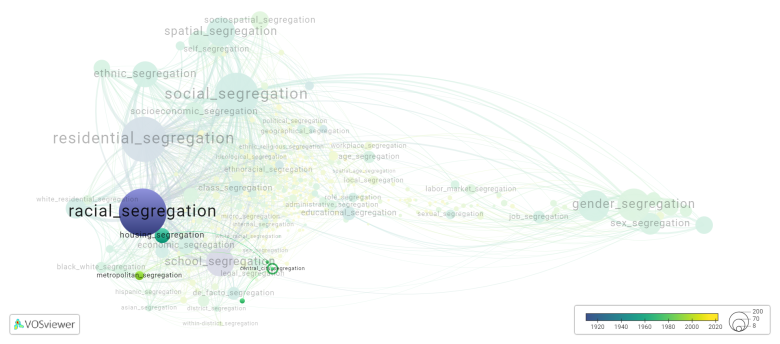Central city segregation: Difference between revisions
(Creating page) |
(Creating page) |
||
| (8 intermediate revisions by the same user not shown) | |||
| Line 12: | Line 12: | ||
Efforts to address central city segregation have taken various forms, including fair housing laws, affordable housing initiatives, and community development programs. However, segregation remains a persistent issue in many cities, with deeply rooted patterns that continue to perpetuate inequality and limit social mobility for disadvantaged groups. | Efforts to address central city segregation have taken various forms, including fair housing laws, affordable housing initiatives, and community development programs. However, segregation remains a persistent issue in many cities, with deeply rooted patterns that continue to perpetuate inequality and limit social mobility for disadvantaged groups. | ||
==See also== | ==See also== | ||
==Related segregation forms== | |||
Central city segregation is frequently discussed in the literature with the following segregation forms: | |||
[[metropolitan housing segregation]], [[housing segregation]], [[racial segregation]], [[metropolitan segregation]] | |||
[[File:central_city_segregation.png|780x780px]] | |||
This visualization is based on the study [[Segregation_Wiki:About| The Multidisciplinary Landscape of Segregation Research]]. | |||
For the complete network of interrelated segregation forms, please refer to: | |||
* [https://tinyurl.com/2235lkhw First year of publication] | |||
* [https://tinyurl.com/2d8wg5n3 Louvain clusters] | |||
* [https://tinyurl.com/223udk5r Betweenness centrality] | |||
* [https://tinyurl.com/244d8unz Disciplines in which segregation forms first emerged (Scopus database).] | |||
==References== | ==References== | ||
==Notes== | ==Notes== | ||
<references /> | <references /> | ||
{{NoteAI}} | {{NoteAI}} | ||
==Central | ==Central city segregation appears in the following literature== | ||
FARLEy J.E. (1982). BLACK MALE UNEMPLOyMENT IN U.S. METROPOLITAN AREAS: THE ROLE OF BLACK CENTRAL CITy SEGREGATION AND JOB DECENTRALIZATION. ''Journal of Urban Affairs'', ''4''(3), 19-34. https://doi.org/10.1111/j.1467-9906.1982.tb00062.x | FARLEy J.E. (1982). BLACK MALE UNEMPLOyMENT IN U.S. METROPOLITAN AREAS: THE ROLE OF BLACK CENTRAL CITy SEGREGATION AND JOB DECENTRALIZATION. ''Journal of Urban Affairs'', ''4''(3), 19-34. https://doi.org/10.1111/j.1467-9906.1982.tb00062.x | ||
Latest revision as of 07:17, 16 October 2024
Date and country of first publication[1][edit | edit source]
1982
United States
Definition[edit | edit source]
Central city segregation refers to the social and spatial division of urban areas based on race, ethnicity, socioeconomic status, and other factors. It typically refers to the concentration of certain racial or ethnic groups in specific neighborhoods or districts within a city, while other groups are concentrated in other areas.
Historically, central city segregation in the United States was primarily enforced through discriminatory housing practices such as redlining, where certain neighborhoods were designated as high-risk for investment or mortgage lending based on racial composition. This led to the exclusion of many minority groups from accessing housing opportunities in desirable urban areas.
The effects of central city segregation are multifaceted and have significant implications for individuals and communities. Segregated neighborhoods often lack access to quality education, healthcare, transportation, and other essential services. Moreover, segregation can perpetuate cycles of poverty and inequality, as concentrated poverty and limited economic opportunities are more prevalent in segregated communities.
Efforts to address central city segregation have taken various forms, including fair housing laws, affordable housing initiatives, and community development programs. However, segregation remains a persistent issue in many cities, with deeply rooted patterns that continue to perpetuate inequality and limit social mobility for disadvantaged groups.
See also[edit | edit source]
Related segregation forms[edit | edit source]
Central city segregation is frequently discussed in the literature with the following segregation forms:
metropolitan housing segregation, housing segregation, racial segregation, metropolitan segregation

This visualization is based on the study The Multidisciplinary Landscape of Segregation Research.
For the complete network of interrelated segregation forms, please refer to:
References[edit | edit source]
Notes[edit | edit source]
- ↑ Date and country of first publication as informed by the Scopus database (December 2023).
At its current state, this definition has been generated by a Large Language Model (LLM) so far without review by an independent researcher or a member of the curating team of segregation experts that keep the Segregation Wiki online. While we strive for accuracy, we cannot guarantee its reliability, completeness and timeliness. Please use this content with caution and verify information as needed. Also, feel free to improve on the definition as you see fit, including the use of references and other informational resources. We value your input in enhancing the quality and accuracy of the definitions of segregation forms collectively offered in the Segregation Wiki ©.
Central city segregation appears in the following literature[edit | edit source]
FARLEy J.E. (1982). BLACK MALE UNEMPLOyMENT IN U.S. METROPOLITAN AREAS: THE ROLE OF BLACK CENTRAL CITy SEGREGATION AND JOB DECENTRALIZATION. Journal of Urban Affairs, 4(3), 19-34. https://doi.org/10.1111/j.1467-9906.1982.tb00062.x
Farley J.E. (1983). Metropolitan housing segregation in 1980: The St. Louis Case. Urban Affairs Review, 18(3), 347-359. https://doi.org/10.1177/004208168301800304
Fischer M.J. (2008). Shifting geographies: Examining the role of suburbanization in blacks' declining segregation. Urban Affairs Review, 43(4), 475-496. https://doi.org/10.1177/1078087407305499
